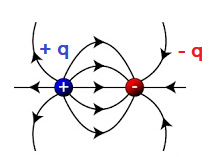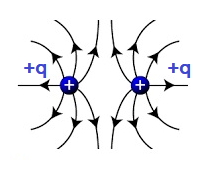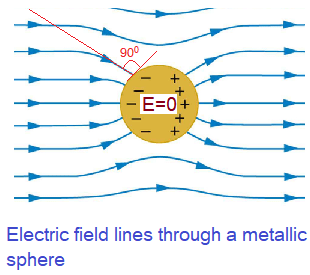Properties of Electric field lines
Electric field lines are the imaginary lines drawn around a charge particle that represents strength of electric field at a point.
- Electric field lines are imaginary but the electric field they represent is real.
- Electric field lines originates from positive charge and terminates towards negative charge. That’s why electric field lines form closed loop. The directions of electric field lines are radially outward (away from the charge) due to positive point charges and radially inward (towards the charge) due to negative charges.

Table of Contents
- The closer the field lines are to each other, the stronger the electric field in that region i.e. The density of electric field lines is proportional to the strength of the electric field in a given region.

- Electric field lines are conservative in nature.
- Electric field lines never cross each other because if they did, it would imply that the electric field had two directions at the same point, which is impossible.
- Electric field lines can be used to determine the force experienced by a charged particle in an electric field.
- Electric field lines can be visualized using various techniques, such as drawing them on paper, using computer simulations, or using physical models.
- Electric field lines due to dipole (a pair of equal and opposite charge).

- Electric field lines due to a pair of two charges having same magnitude and same type/sign.

- Electric field lines through a metallic sphere.

👉👁️🗨️ Video lecture on Properties of Electric field lines
Important questions from the Topic
What are electric field lines?
Ans: Electric field lines are imaginary lines used to represent the direction and strength of an electric field.
What direction do electric field lines point?
Ans: Electric field lines always point away from positive charges and towards negative charges.
Why do electric field lines never intersect each other?
Ans: Electric field lines never cross each other because if they did, it would imply that the electric field had two directions at the same point, which is impossible. A tangent drawn at any point on electric field lines represents direction of electric field at that point.
What does the density of electric field lines represent?
Ans: The density of electric field lines is proportional to the strength of the electric field in a given region.
How can electric field lines be used to determine the force experienced by a charged particle in an electric field?
Ans: Electric field lines can be used to determine the direction of the force on a charged particle by following the direction of the lines. The strength of the force can be determined by the density of the lines in that region.
Can electric field lines be used to visualize magnetic fields?
Ans: No, electric field lines cannot be used to visualize magnetic fields. Instead, magnetic fields are represented using magnetic field lines, which have different properties and behave differently than electric field lines.
Can electric field lines exist inside a conductor?
Ans: No. Inside a conductor, the electric field is zero due to the redistribution of charges on the surface of the conductor. Therefore, electric field lines cannot exist inside a conductor.
Can electric field lines form closed loops in a uniform electric field?
Ans: No, electric field lines cannot form closed loops in a uniform electric field because the field is constant in magnitude and direction throughout the entire region.
How do electric field lines behave near the surface of a charged conductor?
Ans: Near the surface of a charged conductor, electric field lines are perpendicular to the surface, pointing away from positive charges and towards negative charges.
Can two different electric fields have the same electric field lines?
Ans: No, two different electric fields cannot have the same electric field lines because the field lines uniquely represent the direction and strength of the electric field at each point.
Can the number of electric field lines passing through a given area change?
Ans: Yes, the number of electric field lines passing through a given area can change if the strength of the electric field in that region changes. The density of the field lines is proportional to the strength of the electric field, so an increase in the strength of the field would result in an increase in the number of field lines passing through a given area.
MY YouTube Channel Link : 👉🖱 https://www.youtube.com/channel/UCGpC7nWE0-bBv9I53MM8qjQ
Properties of Electric field lines, Properties of Electric field lines, Properties of Electric field lines, Properties of Electric field lines, Properties of Electric field lines, Properties of Electric field lines, Properties of Electric field lines
Hi there very nice site!! Guy .. Excellent .. Superb .. I will bookmark your site and take the feeds also…I am glad to search out a lot of useful info here within the submit, we’d like develop more strategies on this regard, thanks for sharing. . . . . .
Thank you for your review.